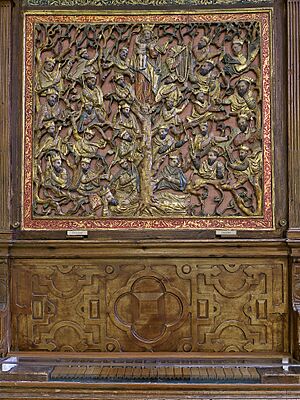Francisco de Salinas facts for kids
Francisco de Salinas (born in 1513 in Burgos, Spain, died in 1590 in Salamanca) was a very important Spanish musician. He was a music expert and played the organ. He is famous for being one of the first people to describe how to tune musical instruments in a very exact, mathematical way. He also helped explain a tuning system called "19 equal temperament." This system uses 19 notes in an octave, which is different from the 12 notes we usually hear today.
In his book, De musica libri septem (published in 1577), he talked about different ways to tune instruments. He wrote about tunings like "1/3-comma meantone." He said this tuning sounded "languid" (a bit sad or slow) but not "offensive to the ear." He also noted that a keyboard with 19 notes in an octave could use this tuning well.
A music historian named Alexander John Ellis thought Salinas might have made a mistake because he was blind. Ellis believed Salinas meant a slightly different tuning. However, others think Salinas's descriptions fit the 1/3-comma tuning better.
Salinas was also interested in "just intonation." This is another way of tuning notes to sound perfectly in tune with each other. He suggested a special scale with 24 notes that he called instrumentum perfectum.
Life of Francisco de Salinas

Francisco de Salinas was born in Burgos in 1513. His father was a treasurer for Emperor Charles I. Francisco became blind when he was eleven years old. He studied many subjects, including singing and organ, at the University of Salamanca.
Later, he worked for a relative, Archbishop Pedro Sarmiento de Salinas. He went with the Archbishop to Rome in 1538. Archbishop Sarmiento became a cardinal that year. Salinas then became a priest and received money each year from Pope Paul III. Salinas lived in Rome for the next 23 years.
In 1553, he became the organist at the court of Naples. There, he worked for the Viceroy of Naples, the Duke of Alba. While in Naples, he became friends with Diego Ortiz, who was a music director. He also met famous musicians like Orlando di Lasso and Tomás Luis de Victoria.
Return to Spain
In 1559, Salinas returned to Spain. He became an organist at the Cathedral of Sigüenza. In 1561, he moved to a similar job at the Cathedral of León.
In 1567, he became a music professor at the University of Salamanca. There, he met the famous poet Fray Luis de León, who was also a professor. In 1571, Salinas, Fray Luis de León, and Diego de Castilla (the head of the university) were judges for a writing contest. This contest celebrated Spain's victory at the Battle of Lepanto and the birth of Prince Ferdinand. Fray Luis de León greatly admired Salinas. In 1577, he wrote a famous poem called Oda a Francisco Salinas to honor the musician.
Most of Salinas's important work was published while he taught at Salamanca. In 1577, he wrote his book De Musica libri septem. In this book, he described "meantone temperament" for the first time. He also taught Vicente Espinel, who later said Salinas was "the most learned man in speculative music that the world has known since antiquity." Even though he was a highly respected organist, all of his own musical compositions have been lost. Francisco de Salinas died in Salamanca in 1590.
See also
 In Spanish: Francisco de Salinas para niños
In Spanish: Francisco de Salinas para niños


